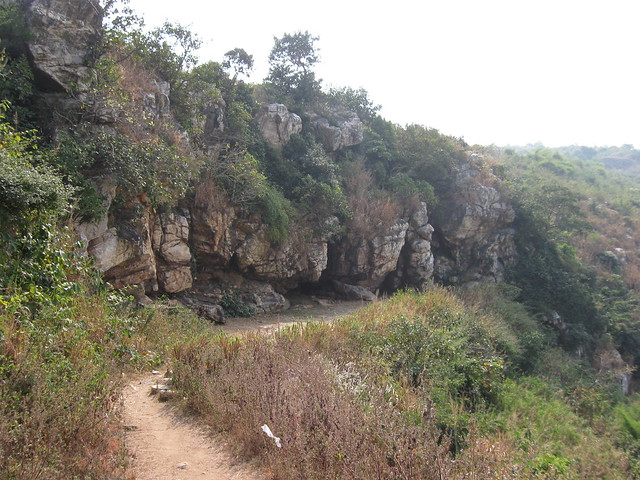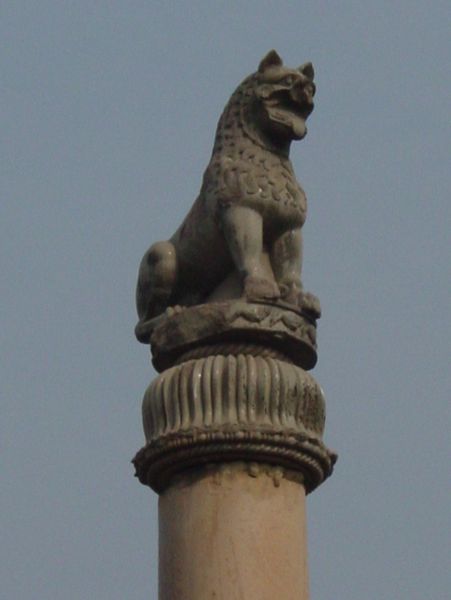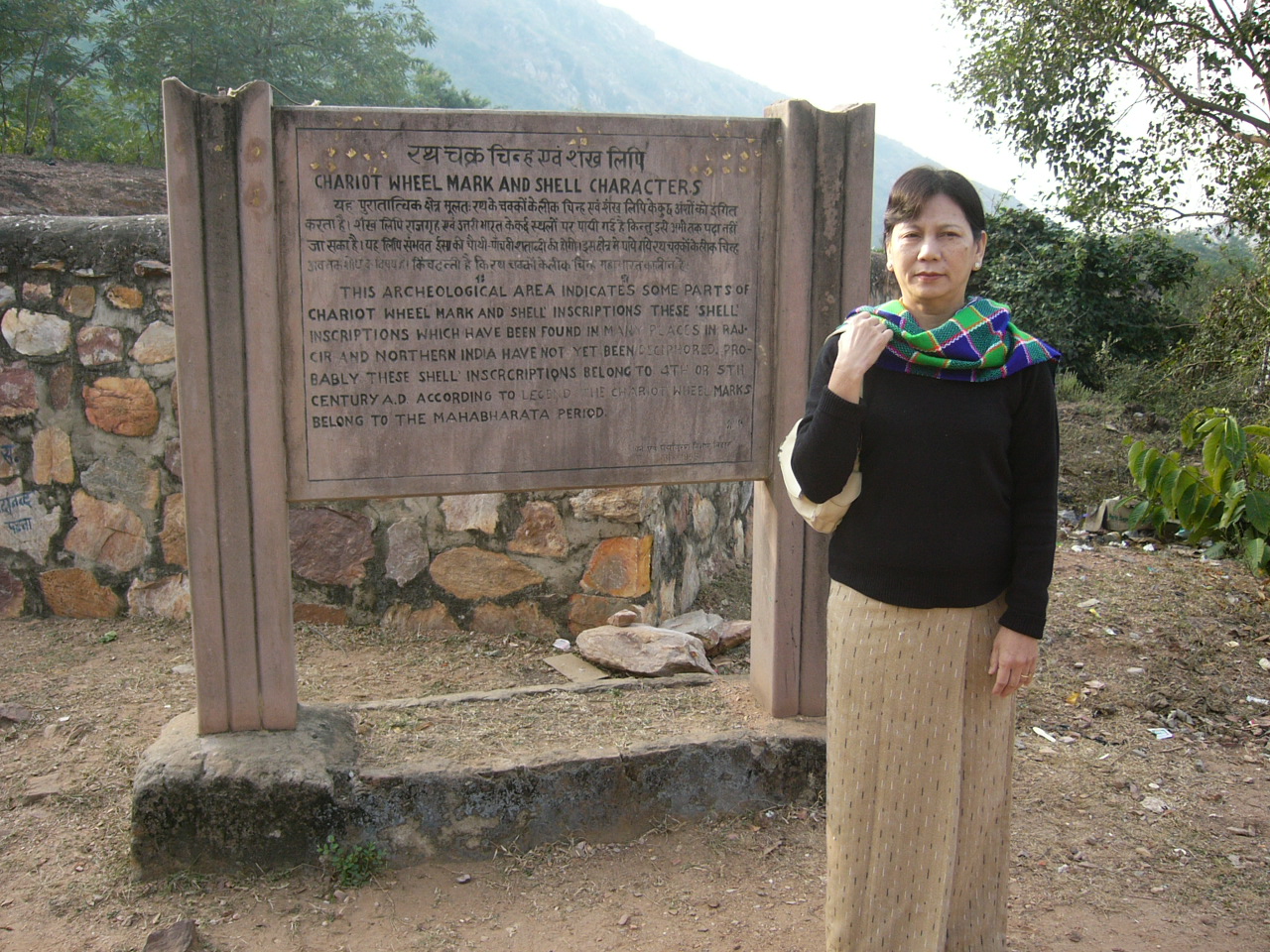The town of Rajgir is situated about 15 km from Nalanda in the state of Bihar. Being located in a valley, Rajgir is a very scenic place. The small hill grit town is covered with lush green forest which add to the beauty of the place. Rajgir was the capital of the Magadh Mahajanpad (State) when Patliputra was not formed. In those days it was called Rajgrih. Rajgir or Rajgrih means the home of Royalty. This place has been associated with Lord Buddha and Buddhism. Buddha not only spent many years in Rajgir but also delivered sermons here and proselytized emperor Bimbisar at the Griddhakoota hill. The Jivekarmavan monastery was the favorite residence for Buddha. Even Bimbisar gave Venuvan Vihar to Buddha for his residence. It is said that it was at Rajgir that physician treated Buddha, Jivak after he was injured by his cousin Devdatta.The teachings of Buddha was penned down at Rajgir and it was also the venue for the first Buddhist Council. Today Rajgir has come up as one of the most important pilgrimage for the Buddhist.
How to reach here:
By Air: The nearest airport is at Patna 101 km away.
By Rail: Though Rajgir itself has a railway station yet the nearest convenient rail head is at Gaya 78 km.
Places you must visit:
Jivaka Ambavana or Jivakarama Vihara is a part of the Jivakameavan Gardens of Rajgir City. Jivaka used to be a royal physician of the Magadh's rulers namely Bimbisara and Ajatshatru. The tales of his surgical tales have also been mentioned in several Buddhist texts.Jivaka was also a great follower of Lord Buddha and has also gifted him a mango garden. It is also said that Lord Buddha once came here to get his wound treated by Jivaka. This garden also comprises the ruins of a monastery. These ruins lie on the way to the ropeway station of Griddhakuta Hill.

Ancient 40 km wall , better known as the Cyclopean wall once encircled Rajgir. Built of massive undressed stone carefully fitted together, the wall is one of the few important Pre-Maurayan stone structures ever to have been found. Traces of wall still subsist, particularly at the exit of Rajgir to Gaya. This wall was constructed before the Mauryan rule.


Monastery Venuvana Vihara : When King Bimbisara heard that the Buddha had come to Rajgir with a retinue of one thousand Arahants, he went to the Sapling Grove to meet the Buddha and was converted by the Buddha, attaining the First Stage of Sainthood. Thereafter, he invited the Buddha to his palace for the following day’s meal, after which he donated the famous Bamboo Grove or Veluvana, the first donation of a park (arama), to the Buddha. The cemetery is believed to be the site of the Veluvana Vihara built by Bimbisara for the Buddha’s residence. The whole area has been cleaned up and Veluvana now looks like a pleasant park, planted with shade trees, bamboo and flowers, reflecting its original status as the royal park of King Bimbisara. In the vicinity of Veluvana is a large pond with a Buddha image at the centre. This pond is believed to be the site of the Karanda tank mentioned in Buddhist text as the Karanda kanivapa where the Buddha used to take his bath.


The Ghora Katora Lake is one of the popular picnic spots of Rajgir. The name of this lake suggests a bowl of horse. The site of this lake is believed to be the place where the stable of Jarasandha was situated. Jarasandha is a famous character from the Hindu mythological epic, Mahabharata.
The Griddhakuta Hill, also known as the hill of vultures, is the most renowned sightseeing attraction in Rajgir situated at an altitude of 400 m. This place is called the vulture peak due to its shape like vulture and also because it is frequently visited by large number of vultures. This hill is said to be the place where Lord Buddha lived for several years as well as preached the Lotus Sutra to convert the Mauryan King Bimbisara. Along with starting of second wheel of law, Lord Buddha also delivered some important sermons to his followers at this very peak.Here also exists a peace pagoda or Shanti Stupa, which is said to have been built by the Buddhists of Japan. There is also an old stone on the way to these hills, which is attributed to king Bimbisara. This stone was even used in the 7th century by the Hiuen-Tsang to reach this place. There are also rock-cut steps on these hills that lead to two natural caves, few plaques and a group of Buddhist Shrines. The caves here include a few Buddhist Statues and the area around it contains ruins of brick stupas.Aerial chairlift facilities are also available in the place to reach the top of this hill. This is a rope way that takes around 8 minutes to reach the hill and along the way it provides a view of the city of Rajgir. On these hills, there is also a village, which is encircled by a cyclopean wall. This wall consists of marks associated with Lord Krishna’s Chariot along with several other historical remains. There are also ruins of a small hut on the top of these hills that is said to have been built by Dhaniya, who was a potter’s son.
,+Rajgir,+Bihar.jpg)
Hot springs are one of the most popular attractions of Rajgir city. These hot springs are situated at the foot of the Vaibhava Hills. The water of these springs comes from the Saptadhara, passing through the back side of Saptaparni Caves. The Brahmakund spring amongst these is considered to be the hottest one with a temperature of around 450 Celsius. At the site of these springs, a separate bathing area for men and women has also been provided.About this place, it is also said that its Tapoda rivulet of hot water was the water spring where even Lord Buddha and Lord Mahavira had taken bath. The water of these hot springs is also considered to have medicinal properties. At the foot of Vaibhava Hills there is also a staircase that leads to various small temples situated in its premises.

Situated near the Vaibhava Hill is a large rectangular stone known as the Jarasandha Ki Baithak. This place is considered to be a military outpost having cells that were used by the pickets as living quarters. Associated with this place, is another significant spot known as Ranbhoomi or Jarasandha's Akhara. This ‘Akhara’ used to be a wrestling arena where a legendary battle was held between Jarasandha and Bhima that lasted for over a month.The specialty of this place is that its soil is soft and white; however, most of it has vanished now after it has been carried by the wrestling enthusiasts that come here. There is also a 30 ft rock situated at this place. This rock is famous for two parallel cuts that are considered to have been marked by the chariot of Lord Krishna.
The Venu Vana Kalandakanivapa used to be the green house of King Bimbisara. The name of this park suggests a bamboo park. The specialty of this park is that it comprises a Buddhist Monastery, which Bimbisara built here in honour of Lord Buddha. The place also comprises a pond called Kalandakanivapa, which means feeding ground of squirrels or jays.

The Maniyar Math is situated in the middle of the valley of Rajgir, near the main road. This structure has been created in the shape of a stupa and has been provided shelter through a conical corrugated iron shade. It has been named after a small shrine that was discovered here in an excavation held at the site. The structure is a hollow stupa having stucco Buddha photos on its outer walls.The place is also considered to have remained a Hindu temple dedicated to snakes, as several statues of snake goddess are also seen here. Rajgir has also been referred to as the abode of Mani Naga, in the epic of Mahabharata.

The Saptaparni Caves are situated on the Vaibhava Hill and are said to be the place where the first Buddhist Council were held. This council was held here after six months after the 'Mahaparinirvana' of Buddha. This council was attended by over 500 monks and was led by Buddha's chief disciple namely Maha Kashyapa. A Magadha ruler named Ajatshatru also built a Sabha Mandap in front of these caves, which was used for this assembly.


The Shankhalipi inscriptions are seen engraved on a rocky terrain, in a site situated at 2 km from the Bimbisara jail. Near to these inscriptions, on a rock are also seen two parallel marks that are said to have been made here by the wheel of Lord Krishna’s Chariot. So, the area around it is believed to have remained a battle field for the fight between Jarasandha and Bhima or it was a training ground for Ajatshatru’s chariot warriors.


Sonabhandara Caves in the southern scarp of Vaibhava Hills are two double storied caves, out of which the western caves are known as Sonabhandara or Swarna Bhandara Caves. These caves comprise black stone statues of first four Jain Tirthankars along with several statues of Lord Buddha. The name of these caves suggests a huge treasury of gold which has been given to it out of the belief that a large treasure of gold lies in their inner walls.It is said that both the caves in this place were carved out of a single massive rock. One of the chambers of these caves is believed to have been the guard room, whose doorway lead to King Bimbisara’s treasury. An inscription in Sankhlipi or shell script written on its walls is believed to give a clue for opening its doorway. The ancient treasury of Bimbisara is said to be still intact in the place.

The Vishwa Shanti Stupa is an ancient pillar or peace pagoda in Rajgir. This pillar is situated on top of Griddhakuta or Ratnagiri Hill, at an altitude of 400 m above the sea level. This pillar was built by the Japanese as a symbol of world peace. The structure is built completely in marble and comprises four golden statues of Lord Buddha with each representing his life periods of birth, enlightenment, preaching and death. The way to reach this ‘stupa’ includes an aerial ropeway. A temple is also situated near this Stupa called the ‘Nipponzan Myohoji’.


The Ajatshatru Fort is associated with Magadha’s ruler Ajatshatru. This fort was built by him in the 6th century BC. Near this fort, there is also a stupa spread in an area of 6.5 sq km. The ruins of the famous Cyclopean Wall are also seen around this place.

The Bimbisara Jail is situated on the southern side of Maniyar Math, on the main road. This Jail is the place where King Bimbisara was imprisoned by his son Ajatshatru, during his last days of life. This place was chosen by the king himself for his incarceration, as from here he could see Lord Buddha going up the Griddhakuta Hill for meditation. This jail also provides a panoramic view of the Japanese Peace Pagoda, on the hill.

Rajgir is home to 26 Jain temples that are situated on its hill crest. These temples are mainly popular amongst the Jain followers as the Buddhists. The way to reach the area is a tough terrain as well as a popular trekking route of the region.


Rajgir is also home to the Jarasandha Akhara of the mythological fighter of Mahabharata namely Jarasandha. Legends tell that at this place Bhima defeated Jarasandha in one of their duel fights.
Lauria Nandangarh is mainly famous for its lion pillar, built by Ashoka. This pillar is built from 8.5 m thick polished sandstone and has edict engravings on it. The place is also said to comprise the ashes of Lord Buddha.


The Chariot Route and hell inscriptions are worth a visit for the strangeness of the phenomenon, two parallel furrows cut deep into rock for about thirty feet giving credence to the local belief that they were "burnt" into the rock by the speed and power of Lord Krishna's chariot when he entered the city of Rajgir during the epic Mahabharata times. Several shell inscriptions, the undeciphered characters current in central and eastern India from the 1st to 5th centuries AD, and engraved in the rock around the chariot marks.


No comments:
Post a Comment